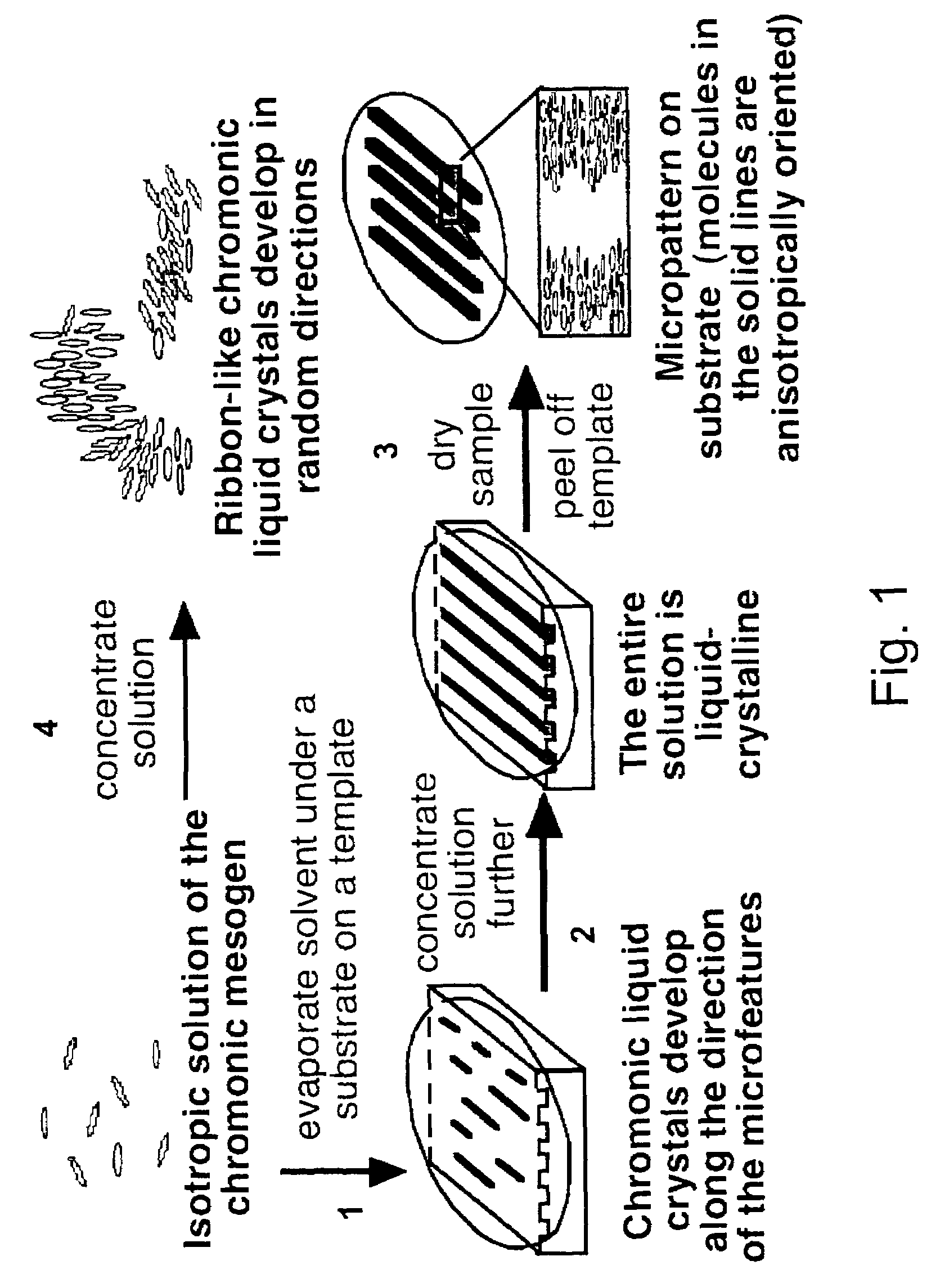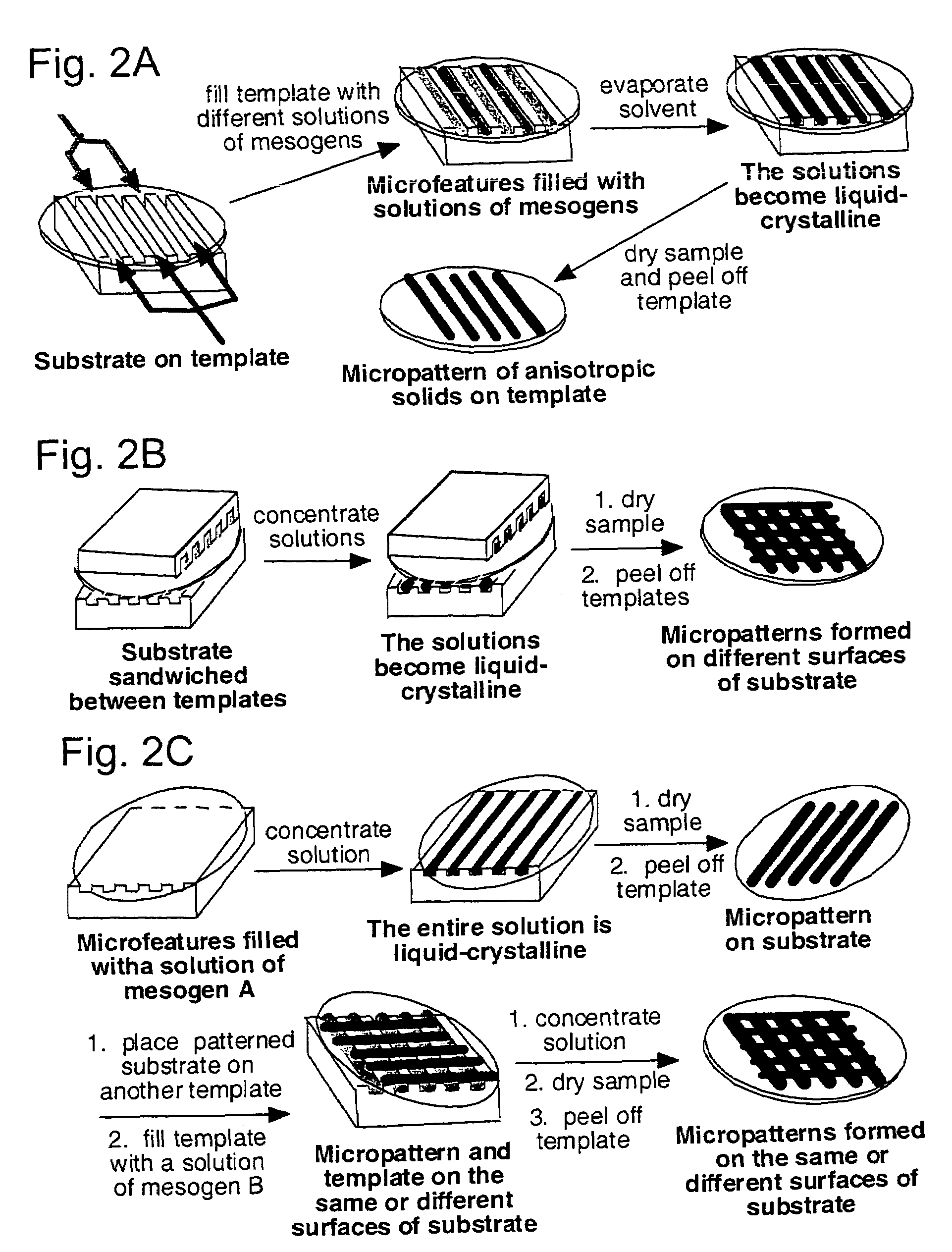Materials and methods for the preparation of anisotropically-ordered solids
a technology materials, applied in the field of methods for controlling the self-organization of organic compounds, can solve the problems of limiting the processibility, control and reproducibility of anisotropic organic materials, and currently available methods for micro-patterning anisotropic organic materials, so as to enhance the self-organization and aggregation of molecules
- Summary
- Abstract
- Description
- Claims
- Application Information
AI Technical Summary
Problems solved by technology
Method used
Image
Examples
example 1
[0248]This example describes an improved method for the synthesis of quaterrylene bis(dicarboximide)s, in particularly ionic quaterrylene bis(dicarboximide)s Ia and Ib, as outlined in Scheme 1. (See also: -W. Tam-Chang, W. Seo and I. K. Iverson (2004) J. Org. Chem. 69:2719-2726 which is incorporated herein in its entirety.)
[0249]
[0250]Ia is the compound of formula I, where q is 0 and R is —CH2CH2N+H(Et)2 (where Et is ethyl) and with suitable counterion (e.g., Cl− or HCOO−); Ib is the compound of formula I, where q is 0 and R is —CH2CH2N+R″(Et)2, where R″ is ethyl or methyl with suitable counterion (e.g., Br−, HCOO− or 4-CH3-phenyl-SO3−).
[0251]The procedure previously reported for the synthesis of non-ionic quaterrylene-bis(dicarboximide) (Quante, H. I; Mullen, K. (1995) Angew, Chem. Int. Ed. Engl. 34:1323 and Geerts Y. et al. (1998) J. Mater. Chem. 8:2357-2369) cannot be used for the synthesis of ionic quaterrylenebis(dicarboximide)s (e.g. Ia and Ib) because it causes the oxidative ...
example 2
[0260]In this example, compounds IIa-d were synthesized according to the procedure described below. Compounds of formula II where R is negatively charge have formula:
[0261]
[0262]Compounds IIa-d have above formula where n is 1, R′ is H, R is —CHR″COO− and R″ is H or alkyl and with suitable counterion (e.g., K+): for Compound IIa, R″ is H, for Compound IIb, R″ is methyl; for Compound IIc, R″ is —CH(CH3)2, and for Compound IId, R″ is —CH2CH(CH3)2.
[0263]Perylenetetracarboxylic dianhydride (PTCA) (3.52 g, 8.97 mmol) was suspended in dimethyl sulfoxide (DMSO, 338 mL) and heated to about 100° C. A solution of glycine (16.84 g, 224.31 mmol) and 87.6% KOH (14.37 g, 224.31 mmol) in water (25 mL) was added drop-wise to the suspension. The mixture was stirred at about 100° C. for 3 hours. The resulting suspension was cooled to RT and the precipitate was collected by vacuum filtration. The residue was washed with a DMSO / water mixture (v / v=67:33) and methanol. To remove DMSO from the product, the...
example 3
[0268]In this example, monoimide IIIa-k were synthesized according to the procedure described below (Scheme 2). In addition, studies by polarized optical microscopy showed that these compounds exhibit lyotropic liquid-crystalline properties in aqueous solution. These compounds also exhibit fluorescence properties in solution (aqueous or organic) and in solid phase. Some of these compounds (including, but not limited to compounds IIIc, IIIf-IIIk) exhibit uv-vis absorption properties that are pH dependent and fluorescence properties that are dependent on the solvent, pH, and the absence or presence of biologically relevant molecules such as nucleic acids (DNA, RNA, and oligonucleotides.)
[0269]
[0270]Compound IIIa was prepared by reaction of compound 4 (see structure shown in Scheme 1) with hydrochloric acid, formic acid, or p-toluenesulfonic acid.
[0271]For example, N,N-diethylaminoethylperylene-3,4-dicarboximide 4 (0.350 g, 0.841 mmol), a magnetic stirring bar, p-toluenesulfonic acid (...
PUM
 Login to View More
Login to View More Abstract
Description
Claims
Application Information
 Login to View More
Login to View More - R&D
- Intellectual Property
- Life Sciences
- Materials
- Tech Scout
- Unparalleled Data Quality
- Higher Quality Content
- 60% Fewer Hallucinations
Browse by: Latest US Patents, China's latest patents, Technical Efficacy Thesaurus, Application Domain, Technology Topic, Popular Technical Reports.
© 2025 PatSnap. All rights reserved.Legal|Privacy policy|Modern Slavery Act Transparency Statement|Sitemap|About US| Contact US: help@patsnap.com



